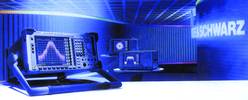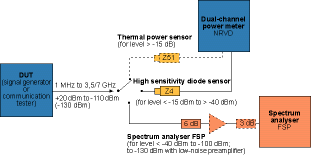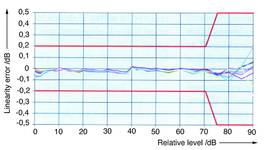Fast and precise measurement of low RF levels
14 March 2001
Test & Measurement
Roland Minihold, Rohde & Schwarz
Some measurements require very low and highly accurate RF levels (typically -100 to -110 dBm), eg for the BER (bit error rate) of digital communication receivers. This R&S test hint summarises how to calibrate extremely precisely, the levels of signal generators and communication testers used for BER measurements.
Rohde & Schwarz' spectrum analyser features measurement uncertainty of 0,5 dB, minimum sweep time of 2,5 ms and up to 30 measurements per second on the IEC/IEEE bus (GPIB). It comes in four models with upper frequencies 3 GHz, 7 GHz, 13 GHz and 30 GHz
Certain digitally modulated signals, such as IS-95 or WCDMA, exhibit a high crest factor. A power meter with a thermal sensor is best suited for determining their levels. For this purpose, Rohde & Schwarz offers the dual-channel power meter NRVD with thermal power sensor NRV-Z51 or NRV-Z52. Due to the limited sensitivity of thermal power sensors, only relatively high levels can be measured (typ greater than and equal to 3330 dBm).
Diode sensors provide comparable measurement accuracy for RF levels down to about -50 dBm due to higher sensitivity. Care should be taken, however, that they are only used in the square law region. Extra measurement uncertainties can occur otherwise in the case of signals with high crest factor or with harmonics. For the high-sensitivity diode sensor NRV-Z4 such effects are negligible in the range -40 dBm ±10 dB.
Figure 1. Suggested test setup to determine small RF levels
The significantly lower RF levels necessary for BER measurements can only be measured with a selective RF receiver or a spectrum analyser. But their absolute measurement uncertainty - even that of a state-of-the art spectrum analyser like the R&S FSP - is higher (0,5 dB) compared to high-quality power meters.
The point of this test hint is to eliminate the absolute error of the FSP spectrum analyser by calibrating it to the dual-channel power meter NRVD with high-sensitivity diode sensor NRV-Z4 for a reference level of approximately -40 dBm (Figure 1). When measuring tiny levels, only the very small linearity error of the FSP that occurs with digital bandwidths adds to the measurement uncertainty of the power meter (Figure 2). Thus a total measurement uncertainty of 0,26 dB can be achieved when measuring a level of -110 dBm.
Figure 2. Linearity error of the FSP spectrum analyser, measured on eight different units (resolution bandwidth 300 Hz)
If necessary, the measurement range can be extended to approximately -130 dBm by means of a low-noise preamplifier. Using the zero span measurement and integration in the (time domain power RMS) of the FSP, the maximum possible measurement speed can be obtained for a given S/N ratio. Application Note 1MA21 provides a detailed description of this procedure and can be downloaded from the Rohde & Schwarz website.
For further information contact Protea Communication & Measurement, (011) 786 3647.
Further reading:
New technique for measuring DNA damage could improve cancer therapy
Test & Measurement
Scientists at the National Institute of Standards and Technology have developed a new technology for measuring how radiation damages DNA molecules.
Read more...
Precise DC power analysis
Conical Technologies
Test & Measurement
The ITECH IT2705 DC power analyser is designed to help engineers and researchers capture it all, from the tiniest deep sleep currents to the highest peak operating loads.
Read more...
What is a JTAG connector?
Spectrum Concepts
Test & Measurement
JTAG was originally created to test for common problems, but lately, it has become a way of configuring devices.
Read more...
SIGLENT launches new 8 GHz DSO
Vepac Electronics
Test & Measurement
SIGLENT has unveiled the enhanced SDS7000A/AP models, building on the success of its SDS7000A high-resolution digital oscilloscope series.
Read more...
Multi-functional high-res oscilloscopes
Coral-i Solutions
Test & Measurement
RIGOL Technologies has launched two powerful additions to its oscilloscope portfolio that are tailored to meet the growing challenges of power electronics, automotive systems, and high-speed digital designs.
Read more...
TDK expands programmable PSU series
Accutronics
Test & Measurement
With a 3U high chassis, the GAC and GAC-PRO provide extremely high-power density for a fully featured programmable AC power source.
Read more...
Analysing magnetic fields
Accutronics
Test & Measurement
The engineers at Narda Safety Test Solutions have achieved a breakthrough in isotropic measurement and analysis of low-frequency magnetic fields in the form of their latest digital H-field probe.
Read more...
A new class of sampling scope
Comtest
Test & Measurement
The PicoScope 9400A Series combines the huge analogue bandwidth of sampling oscilloscopes with the triggering architecture of real-time oscilloscopes.
Read more...
Single channel, programmable PSU
Electrocomp Express
Test & Measurement
Rohde & Schwarz’ NGC101 is a NGC100-series power supply with a wide range of functions that make them ideal for use in development labs and industrial environments.
Read more...
Next-gen LineScan camera
Eagle Africa Technology
Test & Measurement
New Imaging Technologies has launched the new LiSaSWIR, its next-generation SWIR LineScan camera and sensor.
Read more...




